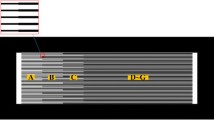Abstract
Micro heat pipes (MHPs) with excellent heat transfer performance have been the ideal radiating components to meet increasingly higher requirements posed by high heat-flux products. Based on MHPs’ working principle, this study deduced capillary limit of a novel MHP with compound structure of sintered wick on grooved substrate, and probed into its forming mechanism: first, high-speed oil-filled spinning was applied to fabricating micro grooves, with optimal spinning and drawing speeds determined; then a mini-type vibration machine was used to help fill copper powders fast and uniformly, with appropriate sintering temperature and time fixed; the manufacturing method that integrates vacuum-pumping–cold-welding with secondary-degassing–cold-welding to increase vacuumizing efficiency. The results of experiments on its heat transfer performance show that the MHPs with sintered-wick-on-grooved-substrate structure fabricated through the proposed forming method can not only acquire much better heat transfer performance, but have advantages such as higher productivity and lower cost.






















Similar content being viewed by others
References
Zaghdoudi MC, Maalej S, Mansouri J et al (2011) Flat miniature heat pipes for electronics cooling: state of the art, experimental and theoretical analysis. World Acad Sci Eng Technol 51(3):879–902
Vasiliev LL (2006) Micro and miniature heat pipes—electronic component coolers. Appl Therm Eng 33(8):105–113
Zhu DS, Lei J, Wang CH et al (2009) Research progress in electronic component heat dissipation using thermoelectric cooling technology. Microelectronics 39(1):94–100 (in Chinese)
Choi JH, Sung BH, Yoo JH et al (2012) Enhanced miniature loop heat pipe cooling system for high power density electronics. J Therm Sci Eng Appl 4(2):1–7
Zhang H, Yang J, Zhuang J (2009) Application of heat pipe in energy conservation technology. Chemical Industry Press, Beijing, pp 1–10 (in Chinese)
Wang H, Tang Y, Yu JJ (2010) Recent advances of the phase change micro-channel cooling structure. J Mech Eng 46(24):101–106 (in Chinese)
Suman B (2008) Effects of a surface-tension gradient on the performance of a micro-grooved heat pipe: an analytical study. Microfluid Nanofluid 5:655–667
Oh KH, Lim H, Im H et al (2009) Manufacturing process of copper microgrooves utilizing a novel optical fiber-based laser-induced etching technique. Int J Precis Eng Manuf 10(3):155–160
Xin GM, Cui KH, Zou Y et al (2009) Development of sintered Ni–Cu wicks for loop heat pipes. Sci China Ser E Technol Sci 52(6):1607–1612
Zhu WF, Chen YP, Zhang CB et al (2009) Flowing and heat transfer characteristics of heat pipe with axially swallow-tailed microgrooves. J Astronaut 30(6):2380–2386 (in Chinese)
Chen YP, Zhu WF, Zhang CB et al (2010) Thermal characteristics of heat pipe with axially swallow-tailed microgrooves. Chin J Chem Eng 18(2):185–193
Lin YJ, Hwang KS (2009) Effects of particle size and particle size distribution on heat dissipation of heat pipes with sintered porous wicks. Metall Mater Trans A 40A(9):2071–2078
Li Y, Chen CY, Jie ZW et al (2012) Effect of copper particle size on heat transfer performance of sintered heat pipe. J S China Univ Technol (Nat Sci Ed) 40(3):156–161 (in Chinese)
Li Y, He HF, Zeng ZX (2013) Evaporation and condensation heat transfer in a heat pipe with a sintered-grooved composite wick. Appl Therm Eng 50(1):342–351
Li XB, Wang JJ, Hu QM et al (2013) Experimental and theoretical research on capillary limit of micro heat pipe with compound structure of sintered wick on trapezium-grooved substrate. Heat Mass Transf 49(3):381–389
Chen P, Liu XK, Tang Y et al (2005) Research on ploughing–extrusion process mechanism of multi/micro dimensional grooves inside cylindrical micro heat pipe. J Harbin Inst Technol (New Ser) 12(2):1–4
Zhao XL, Tang Y, Chen P (2006) Extrusion–ploughing process model and experiment research on fabrication of micro groove with fin structure. 2006 international technology and innovation conference, 2006, 524:755–760
Li Y, Tang Y, Li XB et al (2008) Study on inner micro-grooves of heat pipe spinning process and multi-tooth mandrel. Key Eng Mater 375–376:358–363
Li Y, Xiao H, Lian B et al (2008) Forming method of axial micro grooves inside copper heat pipe. Trans Nonferr Met Soc China (Engl Ed) 18(5):1229–1233
Li XB, Tang Y, Li Y et al (2010) Sintering technology for micro heat pipe with sintered wick. J Cent S Univ Technol 17(1):102–109
Ou DS, Tang Y, Wan ZP et al (2012) Effect of drawing parameters on elongation of micro copper tube with straight grooves. Key Eng Mater 499:62–67
Fang XM, Wan ZP, Tang Y (2011) Experimental study of axial micro-grooves of micro-heat pipe forming via high-speed oil-filled spinning. Mech Sci Technol Aerosp Eng 30(5):727–731 (in Chinese)
Li XB, Li Y, Tang Y et al (2008) Forming method of sintered wick in micro heat pipe. J S China Univ Technol (Nat Sci Ed) 36(10):114–119 (in Chinese)
Li XB (2009) Study on manufacturing method and heat transfer capability of micro heat pipe with sintered wick. South China University of Technology, Guangzhou (in Chinese)
Jiang LL (2011) Manufacture and thermal performance of sintered-grooved composite wick in the flattened heat pipe. South China University of Technology, Guangzhou (in Chinese)
Lu LS, Tang Y, Yuan D et al (2009) Micro heat pipe manufacturing technology of vacuuming and filling work fluid. J Mech Eng 45(6):122–127 (in Chinese)
Li XB, Guo JH, Wang SG et al (2011) Vacuum technologies in fabricating micro heat pipe with sintered wick. Chin J Vac Sci Technol 31(2):187–193 (in Chinese)
Jiang LL, Tang Y, Pan MQ (2011) Effects of bending on heat transfer performance of axial micro-grooved heat pipe. J Cent S Univ Technol 18(18):580–586
Li Y, He T, Zeng ZX (2012) Analysis of collapse in flattening a micro-grooved heat pipe by lateral compression. Chin J Mech Eng 25(6):1210–1217
Acknowledgments
This project supported by University Key Teacher Foundation of Heilongjiang Province of China (1253G065).
Author information
Authors and Affiliations
Corresponding author
Rights and permissions
About this article
Cite this article
Li, X., Li, M., Li, M. et al. Forming method of micro heat pipe with compound structure of sintered wick on grooved substrate. Heat Mass Transfer 52, 581–593 (2016). https://doi.org/10.1007/s00231-015-1585-4
Received:
Accepted:
Published:
Issue Date:
DOI: https://doi.org/10.1007/s00231-015-1585-4




